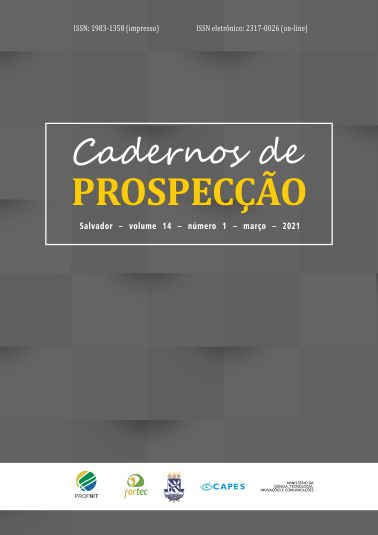Prospective Study of Smart Cities Technologies
DOI:
https://doi.org/10.9771/cp.v14i1.31992Keywords:
Technological Forecasting, Patent, International Patent Classification (IPC).Abstract
Smart Cities are those using information and communication technologies based on a multipurpose network structure. This kind of technology is available through patent information. Thus, this paper aims to characterize Smart City technologies. The results pointed to wireless communication network technologies and traffic control systems as the most recurrent technologies. A small group of companies is responsible for a significant part of patent fillings, and the fields analyzed have different levels of attractiveness, with a predominance of technologies based on wireless communication networks. These results allowed us to evaluate potential threats and opportunities for Brazilian organizations that develop technologies in the technological fields analyzed. The study results also allowed comparative analyzes between institutions and countries, thus generating subsidies to improve industrial property management and investment decisions in Research and Development.
Downloads
References
ALBINO, V.; BERARDI, U.; DANGELICO, R. M. Smart cities: Definitions, dimensions, performance, and initiatives. Journal of Urban Technology, [S.l.], v. 22, n. 1, p. 3-21, 2015.
ANGELIDOU, M. Smart cities: a conjuncture of four forces. Cities, [S.l.], v. 47, p. 95-106, 2015.
ANTHOPOULOS, L. G. The rise of the smart city. In: Understanding Smart Cities: A Tool for Smart Government or an Industrial Trick? [S.l.]: Springer, Cham, p. 5-45, 2017.
ANTHOPOULOS, L. G.; FITSILIS, P. Smart cities and their roles in city competition: A classification. International Journal of Electronic Government Research (IJEGR), [S.l.], v. 10, n. 1, p. 63-77, 2014.
CELLARY, W. Smart governance for smart industries. Proceedings of the 7th International Conference on theory and practice of electronic governance. ACM, 2013. p. 91-93.
FU, Y.; ZHANG, X. Trajectory of urban sustainability concepts: A 35-year bibliometric analysis. Cities, Elsevier, v. 60, p. 113-123, 2017.
FUNG, M. K.; CHOW, W. W. Measuring the intensity of knowledge flow with patent statistics. Economics letters, Elsevier, v. 74, n. 3, p. 353-358, 2002.
GOULD, D. M.; GRUBEN, W. C. The role of intellectual property rights in economic growth. Journal of Development Economics, Elsevier, v. 48, n. 2, p. 323-350, 1996.
GRAHAM, S.; AURIGI, A. Urbanising cyberspace? The nature and potencial of the virtual cities movement. City, [S.l.], v. 2, n. 7, p. 18-39, 1997.
GRILICHES, Z. Patent statistics as economic indicators: a survey. R&D and productivity: The Econometric Evidence, Chicago, University of Chicago Press, p. 287-343, 1998.
HAGEDOORN, J.; CLOODT, M. Measuring innovative performance: is there an advantage in using multiple indicators? Research Policy, S.l.], v. 32, n. 8, p. 1.365-1.379, 2003.
INPI – INSTITUTO NACIONAL DA PROPRIEDADE INDUSTRIAL. Publicação IPC. 2018. Disponível em: http://ipc.inpi.gov.br/ipcpub/. Acesso em: 26 ago. 2018.
KRABBE, E.; SAMPSON, S.; WETHERBEE, I. Patent searching using free search tools. Intellectual Property Owner’s Association, 2017.
NAGAOKA, S.; MOTOHASHI, K.; GOTO, A. Patent statistics as an innovation indicator. Handbook of the Economics of Innovation, [S.l.], Elsevier, v. 2, p. 1.083-1.127, 2010.
OECD – ORGANISATION FOR ECONOMIC CO-OPERATION AND DEVELOPMENT. Patent Statistics Manual 2009. [S.l.]: Organisation for Economic Co-operation and Development, 2009.
PAVITT, K. Patent statistics as indicators of innovative activities: possibilities and problems. Scientometrics, Springer, v. 7, n. 1-2, p. 77-99, 1985.
PELLICER, S. et al. A global perspective of smart cities: A survey. In: 2013 Seventh International Conference on Innovative Mobile and Internet Services in Ubiquitous Computing. IEEE, p. 439-444, 2013.
RASSENFOSSE, G. D. et al. The worldwide count of priority patents: A new indicator of inventive activity. Research Policy, [S.l.], v. 42, n. 3, p. 720-737, 2013.
Downloads
Published
How to Cite
Issue
Section
License
Copyright (c) 2021 Cadernos de Prospecção

This work is licensed under a Creative Commons Attribution-NonCommercial 4.0 International License.
O autor declara que: - Todos os autores foram nomeados. - Está submetendo o manuscrito com o consentimento dos outros autores. - Caso o trabalho submetido tiver sido contratado por algum empregador, tem o consentimento do referido empregador. - Os autores estão cientes de que é condição de publicação que os manuscritos submetidos a esta revista não tenham sido publicados anteriormente e não sejam submetidos ou publicados simultaneamente em outro periódico sem prévia autorização do Conselho Editorial. - Os autores concordam que o seu artigo ou parte dele possa ser distribuído e/ou reproduzido por qualquer forma, incluindo traduções, desde que sejam citados de modo completo esta revista e os autores do manuscrito. - Revista Cadernos de Prospecção está licenciado com uma Licença Creative Commons Attribution 4.0. Esta licença permite que outros remixem, adaptem e criem a partir do seu trabalho para fins não comerciais, e embora os novos trabalhos tenham de lhe atribuir o devido crédito e não possam ser usados para fins comerciais, os usuários não têm de licenciar esses trabalhos derivados sob os mesmos termos.
Este obra está licenciado com uma Licença Creative Commons Atribuição 4.0 Internacional.








